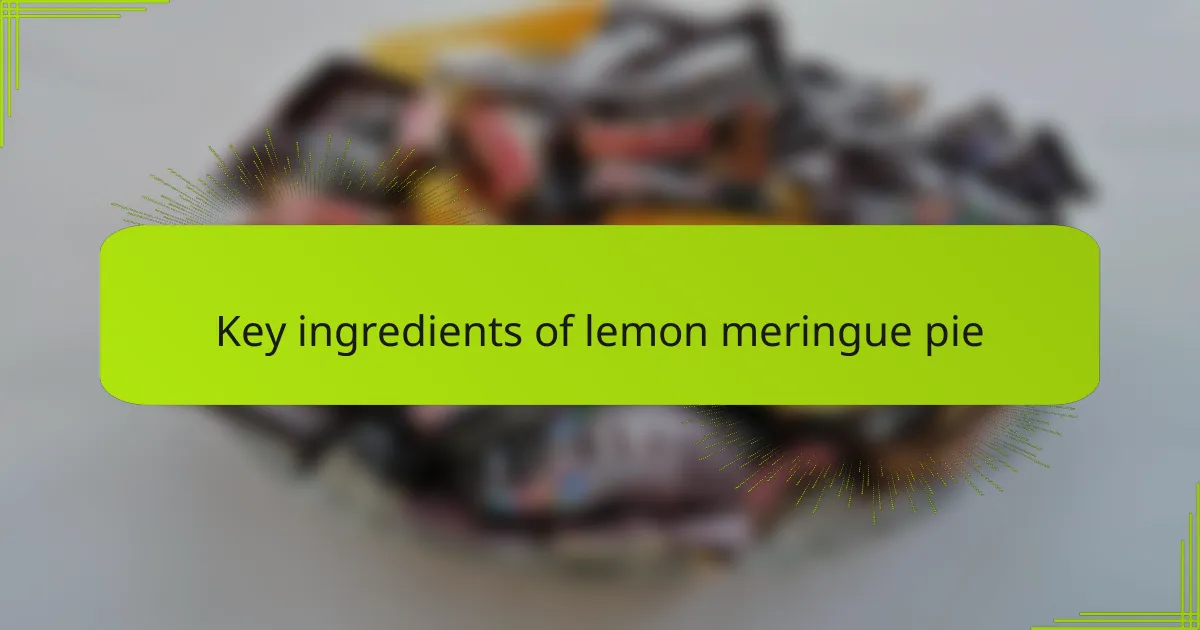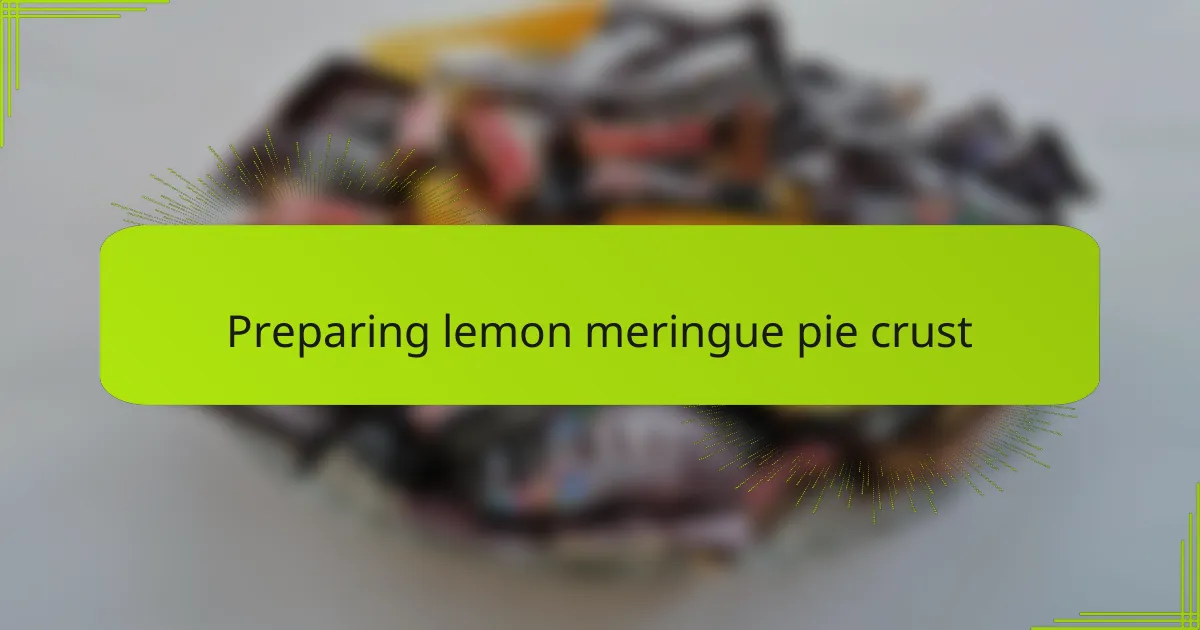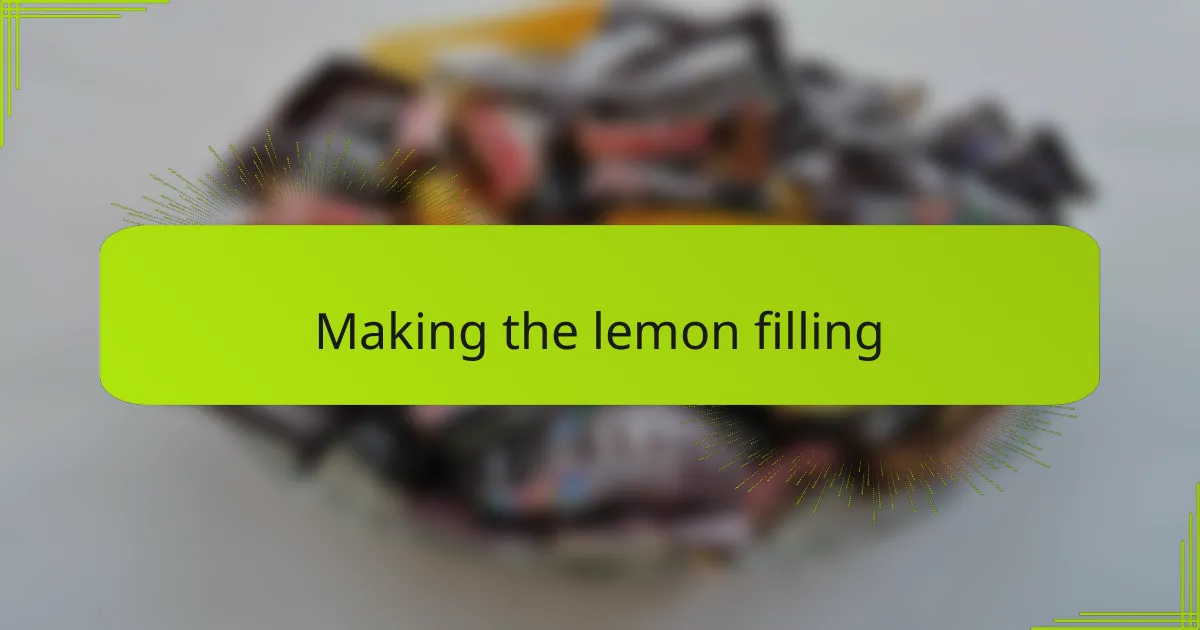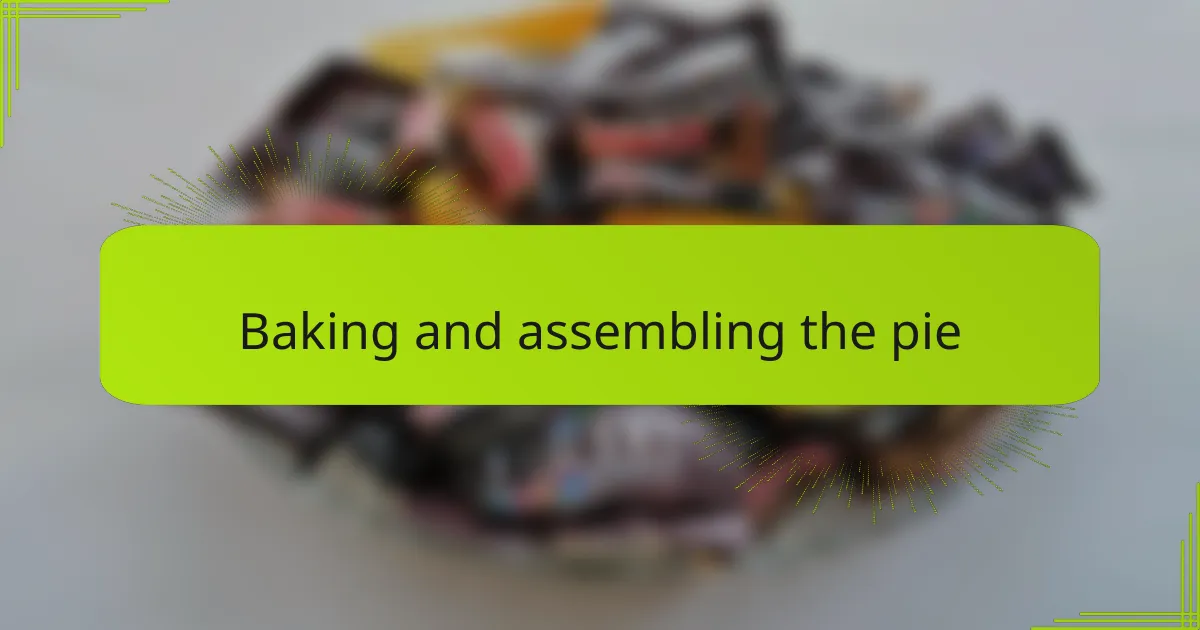Key takeaways
- Lemon meringue pie is a harmonious blend of tart lemon filling and sweet meringue, requiring patience and attention during preparation.
- The crust is essential for structural integrity; blind baking prevents sogginess and ensures a crispy base.
- Making the lemon filling involves balancing flavors carefully, and thickening it provides a rewarding sense of accomplishment.
- Whipping the meringue necessitates room-temperature egg whites and avoiding grease, with gradual sugar addition stabilizing the texture.

Understanding lemon meringue pie
Lemon meringue pie, to me, is more than just a dessert—it’s a delicate balance of flavors and textures that delight the senses. Have you ever noticed how the tartness of the lemon filling contrasts so beautifully with the sweet, airy meringue on top? That contrast is what makes this pie so memorable; it’s like a little burst of sunshine with every bite.
When I first tried making lemon meringue pie, I was surprised by how crucial the meringue was—not just as a garnish but as a vital component that brings lightness and a touch of elegance to the dessert. It has to be whipped just right, creating those soft peaks that melt on your tongue without overshadowing the vibrant lemon base. This interplay is what gives the pie its unique character.
Understanding the pie’s structure also helped me appreciate the patience needed in its preparation. The crust, the tangy lemon filling, and the fluffy meringue each have their own timing and technique, which makes me ask: How often do we rush through recipes without truly savoring the process? With lemon meringue pie, slowing down is part of the joy.

Key ingredients of lemon meringue pie
The crust is the unsung hero here—usually a simple buttery pastry that provides a crisp, flaky base. When I first baked mine, I underestimated the importance of a sturdy crust; without it, the luscious lemon filling can make the pie soggy and lose its charm. Have you ever had a pie where the crust just falls apart? That’s exactly what I wanted to avoid.
Then, there’s the lemon filling, which is all about getting that perfect balance of tartness and sweetness. I remember carefully measuring lemon juice and zest, knowing that too much or too little would throw off the whole flavor. It’s almost like painting—each ingredient blending to create that bright, tangy center you crave.
Finally, the meringue is the pièce de résistance. Whipping egg whites to stiff peaks brings a sense of satisfaction I can’t quite put into words. It’s fluffy yet glossy, with just the right amount of sweetness to complement the sharp lemon. Have you ever watched it brown in the oven, feeling excited and a bit nervous? That moment always makes me feel like a true baker.

Preparing lemon meringue pie crust
Getting the crust right was one of those moments where I realized baking demands both care and patience. I remember rolling out the dough just enough to get it thin and even, but not so thin that it would tear during baking. Have you ever had a crust that shrinks or cracks? I certainly did the first time, and it taught me how crucial chilling the dough beforehand really is.
I also learned the hard way how important blind baking is for lemon meringue pie crusts. Without it, the luscious filling seeps in, turning my crust mushy and disappointing. Poking holes with a fork and placing pie weights on the dough helped me get that crisp, golden base I so craved—such a satisfying transformation to see!
Sometimes, I get caught up in rushing through this step. But honestly, slowing down to prepare the crust properly feels like setting a strong foundation—not just for the pie, but for the whole baking experience. Have you tried embracing this slower rhythm? It changes the way you appreciate each bite later.

Making the lemon filling
Making the lemon filling was a turning point for me—it’s where the magic really begins. I remember squeezing fresh lemons, the bright, zesty aroma filling the kitchen and waking me up better than any coffee could. Have you ever noticed how that fresh citrus scent instantly lifts your spirits? That’s exactly the feeling I wanted to capture in the filling.
Balancing the sugar and lemon juice felt a bit like walking a tightrope. Too sweet, and it loses its zing; too tart, and it becomes overpowering. I learned to taste as I went, adjusting little by little until I found that perfect harmony. It was a lesson in patience and trust, and honestly, one of the most rewarding parts of the whole process.
Then came the thickening stage, where patience really paid off. Watching the mixture slowly thicken on the stove, transforming from a runny liquid to a velvety custard, gave me a real sense of accomplishment. Have you ever had that moment where all your careful stirring just clicks and you know you’ve nailed it? That’s exactly how I felt right then.

Whipping the perfect meringue
Whipping the perfect meringue always seemed a bit intimidating to me at first. I learned that starting with room-temperature egg whites makes a huge difference—they whip up faster and reach those glossy peaks more easily. Have you ever waited impatiently for your meringue to firm up, only to end up with a flat mess? That frustration is real, but the right temperature really helps.
One thing I discovered is the importance of avoiding any grease or yolk in the bowl—just a tiny bit can wreck the whole batch. I once wasted a whole dozen eggs because I wasn’t careful, and I won’t forget that lesson anytime soon. When the meringue finally starts to hold stiff peaks, it feels almost magical, like the lightness of clouds captured in a bowl.
I also play with adding sugar gradually, which not only sweetens but stabilizes the meringue so it holds its shape longer in the oven. Watching it bake to a golden, toasted finish while still keeping a fluffy interior is genuinely rewarding. Don’t you think there’s something satisfying about seeing such delicate perfection come from such simple ingredients?

Baking and assembling the pie
Baking and assembling the pie was where I truly realized how much attention to detail this dessert demands. I recall carefully pouring the luscious lemon filling into the pre-baked crust, making sure not to splash or spill—because a messy crust can ruin that perfect presentation. Have you ever felt that mix of excitement and slight fear as you spread the filling, knowing the final result depends on these small, steady hands?
Then came the meringue—spreading it over the filling felt almost like frosting a cake, but with extra care to seal the edges so it wouldn’t shrink away during baking. I learned that the key is to create peaks and swirls for texture and to achieve that golden, toasted look. Watching the oven transform those whites into a crisp-topped cloud gave me a proud sense of accomplishment I hadn’t expected.
Finally, as the pie cooled, I realized that assembly wasn’t just about putting ingredients together—it was about patience and timing. Have you noticed how letting the pie rest helps the filling set perfectly, making each slice clean and satisfying? This wait felt longer than I anticipated, but every second was worth it when I cut into that beautiful, layered masterpiece.




